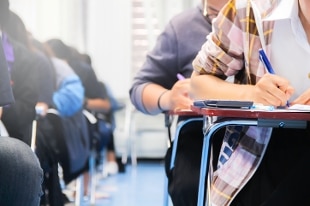Share
01 September 2021 A strategic document for the prevention and control of Sars-Cov-2 infections and a monitoring plan to control the circulation of the virus in institutions have been developed to protect the performance of face-to-face teaching.
The strategic document, aimed at all schools, declines the preventive measures for the upcoming school year such as the spacing of at least one meter between the desks, the use of surgical masks over the age of six, even when seated, the need for frequent air exchange.
These are just some of the main recommendations addressed to schools that can be found in the Interim Strategic Indications Report for the prevention and control of Sars-CoV-2 infections in schools (as 2021-2022) developed by Iss, ministry of Health, Ministry of Education, Inail, Bruno Kessler Foundation, in collaboration with the Extraordinary Commissioner for the Covid-19 Emergency.
These measures have been defined by experts to limit the
chances of contagion
also on the basis of future epidemiological scenarios that could be configured during the school year. Even in the white area, the recommendations on spacing remain, the mandatory nature of the surgical masks in case of impossibility to maintain the distance of at least one meter between the counters and sanitization.
Furthermore, extracurricular activities are allowed in
the white zone
, while the same must be limited in the yellow, orange or red regions. The document also takes stock of the scientific evidence produced so far in Italy by health institutions that demonstrate how the transmission of the virus among young people is linked more to the community than to attendance and school.
Scientific studies also show how the
school staff were
no more at risk of developing Covid-19 infection than other professions.
In addition to the strategic document, a Plan for monitoring the circulation of Sars-CoV-2 was also prepared, in close collaboration with the Regions and with experts in the sector, intended for primary and lower secondary schools, in order to monitor, through a
'' network of sentinel schools '',
the spread of the virus in schools even in asymptomatic subjects. The plan provides for salivary molecular tests conducted, on a voluntary basis, on pupils aged 6-14 in primary and lower secondary schools in Italy.
The '' sentinel schools '' will be indicated by the regional health authorities in collaboration with the school offices.
The campaign will involve at least 55,000 pupils every 15 days and will be supported by the Commissioner Structure in its implementation. The choice of molecular tests on salivary samples was made because these offer a high accuracy of the result and guarantee the advantage of the ease of sample collection.
In a first
'' start-up '' phase,
the activities of collecting samples can be carried out in the school with the help of health personnel, identified by the competent local health authorities or by the staff of the commissioner. Subsequently, the collection of samples will be carried out in the family environment respecting the instructions that guarantee the correctness of its execution. The collection can be carried out independently by the family and the test delivered to collection points.
This also allows the possibility of processing the sample for possible viral genomic sequencing. In the case of positive subjects / contacts (low or high risk), the indications of the Prevention Departments will be followed on the basis of the procedures defined by the respective Region / Autonomous Province, and by the Ministry of Health.

